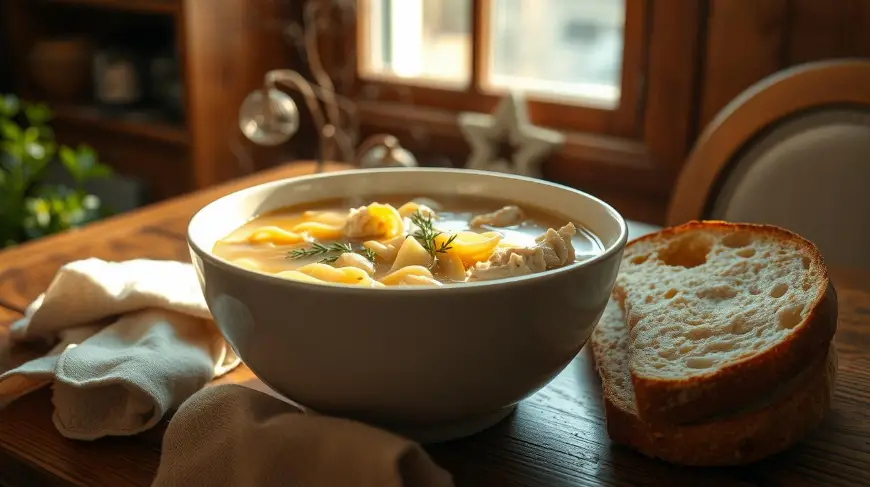There’s something undeniably cozy about a warm bowl of homemade chicken noodle soup. It’s a comfort food classic that has been soothing souls for generations. Made with homestyle egg noodles, thick-cut veggies, and a cozy garlic-herb broth, this dish is the epitome of comfort.

On a chilly day or when you’re feeling under the weather, a steaming bowl can be just what you need. It’s more than just a meal; it’s a cozy hug in a bowl. This beloved recipe is sure to become a family favorite, providing warmth and comfort whenever it’s needed.
What Type of Noodles?
My mather always made chicken noodle soup with homemade egg noodles, but the great thing about this soup is that any kind of noodles will work!
Homemade Egg noodles : all you need is salt, flour, eggs and milk and they’re ready in 6 minutes!
Rotini
Elbow macaroni
Farfalle pasta
What Can I Add to Chicken Soup to Give It Flavor?
You have a lot of opportunity to add flavor to chicken soup throughout the cooking process, starting at the very beginning until you take the pot off the heat.
Season the soup with salt and pepper early on, allowing the flavor to concentrate as the soup simmers.
Taste the soup at the end of cooking. If the flavor tastes a little flat, adding more salt or lemon juice will help.
Sautéing aromatic vegetables, like onion, carrot, and celery then simmering them in the broth adds more flavor. As does mixing in a few sprigs of fresh thyme and dried bay leaves.
Adding fresh herbs like parsley or dill along with lemon juice is a great flavor boost. These additions keep the soup feeling fresh and bright, and the acidity of the lemon rounds out the savoriness of the broth.
Few Tips
Cook the noodles separately, if not eating all of the soup right away. This is because as the noodles sit in the soup, they absorb more and more broth, becoming soggy over time. I’ve found from experience that some egg noodles can hold up well, though most become a soggy mess and fall apart.
Toss in the extra meat from the rotisserie chicken. Depending on the size of the chicken, you may find that after you pull off the meat you need, there’s still more left on the bird. Go ahead and toss it in the soup as well, unless of course you have another plan for the leftover chicken, like making chicken salad.
Cut the vegetables into thick pieces. Keeping the pieces large ensures that they stay tender without getting mushy, and keep their bright coloring.
How long does chicken and noodles last in the fridge?
This will stay good for up to three days in an airtight container in the fridge. Reheat bowls of soup in the microwave or larger portions over low heat on the stove.
INGREDIENTS TO MAKE CHICKEN NOODLE SOUP
Noodles: Egg noodles are a classic pasta to use.
Chicken: Tender thighs infuse the broth with deep, meaty richness. Plus you’ll be able to easily shred the meat when you combine it with the noodles.
Salt and Pepper: Season to extract maximum flavor during simmering.
Butter: Sautéing the veggies in butter releases their natural sugars, enhancing their flavor.
Vegetables: Onions, carrots, and celery ensure a flavorful and aromatic foundation for the broth.
Bay Leaf: This leaf adds a unique depth and complexity to the broth.
Garnish: Fresh parsley offers a herby touch, while lemon juice adds a refreshing tang to each bowl.
Seasonings: Minced garlic and oregano elevate the soup’s flavor profile.

HOW TO MAKE CHICKEN NOODLE SOUP
Add the onion, carrots, celery to a pot with melted butter and season with salt and pepper. Cook, stirring occasionally, until softened.
Next add the garlic and oregano. Cook, stirring constantly, until fragrant.
Place the chicken, bay leaves and the remaining salt and pepper in the pot.
Cover with water, and bring everything to a boil. Reduce the heat and simmer, until the chicken is cooked through.
Add the shredded chicken to the soup along with the egg noodles.
Continue to cook the soup until the pasta is tender. Remove the soup from the heat and stir in the parsley and lemon juice.
HOW TO STORE & REHEAT CHICKEN NOODLE SOUP
Storing: Once the chicken noodle soup has cooled completely, transfer it to an airtight container. If you’re anticipating longer storage, consider keeping the noodles separate to prevent them from becoming soggy.
Reheating: For the best texture, it’s advised to reheat the soup on the stovetop. Pour your desired serving into a pot and heat over medium until simmering. If you’ve stored the noodles separately, add them in the last few minutes to warm through without overcooking.
Chicken Noodle Soup Recipe
Course: soups4
servings10
minutes40
minutes280
kcalThis Easy Chicken Noodle Soup recipe is my all-time favorite winter soup, made with simple ingredients and stocked with nutrients for the cold season!
Ingredients
1 yellow onion diced
3 garlic cloves minced
1 teaspoon black pepper divided
3 large carrots diced
2 tablespoons butter
1 teaspoon oregano
1 ½ teaspoon salt divided
1 ¼ pounds boneless skinless chicken thighs
2 dried bay leaves
8 cups water
3 ounces egg noodles or 2 cups
2 tablespoons lemon juice
2 tablespoons chopped fresh parsley
Directions
- Heat the butter in a large stockpot over medium heat. Add the onion, carrots, celery, 1 teaspoon of salt, and ½ teaspoon of pepper. Cook, stirring occasionally, until softened, about 10 minutes.
- Add the garlic and oregano. Cook, stirring constantly, until fragrant, about 1 minute. Add the chicken, the bay leaves and the remaining salt and pepper.
- Add the water, and bring everything to a boil over medium-high heat. Reduce the heat to medium-low and simmer, covered, until the chicken is cooked through, about 25 minutes.
